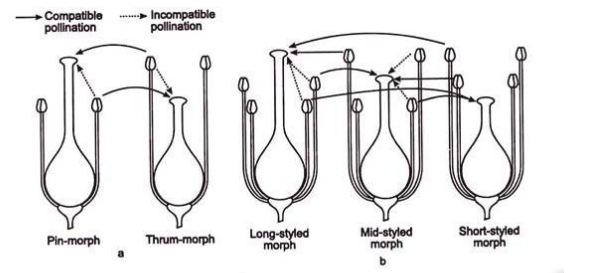Outbreeding Devices MCQ - Practice Questions with Answers
Edited By admin | Updated on Sep 18, 2023 18:34 AM | #NEET
Quick Facts
-
12 Questions around this concept.
Solve by difficulty
Complete the given statement
Flowering plants have developed many devices to discourage ____________and to encourage__________
Concepts Covered - 1
Outbreeding Devices
- Majority of flowering plants produce hermaphrodite flowers and pollen grains are likely to come in contact with the stigma of the same flower.
- Continued self-pollination results in inbreeding depression.
- Flowering plants have developed many devices to discourage self-pollination and to encourage cross-pollination.
1. Dicliny:
- Cross-pollination is the rule among diclinous plants, i.e., those bearing unisexual flowers.
- In dioecious plants, nothing else can take place.
- In monoecious plants, the only alternative is geitonogamy which, however, has the same effect as self-pollination.
2. Dichogamy:
- When stamens and carpels of a bisexual flower mature at different times, pollination between them become ineffective.
- Dichogamy may be of two types:
- Protandry: The anthers ripen first as in most Compositae, many Umbelliferae, Malvaceae, etc. As a result, when the anther bursts, it pollinates stigmas of other flowers but not its own stigma which is not yet ripe.
- Protogyny: The carpel matures first as in many members of Annonaceae (e.g., Annona, Polyalthia) and Magnoliaceae (e.g., Magnolia, Michelia) as well as in Arum maculatum. When the stigma is receptive, its own pollen is riot ripe so that it has to depend on foreign pollens.
3. Herkogamy:
- In some flowers, there may be some physical barrier between the anther and the style so that pollination between them is rendered difficult or even impossible.
- In many Cruciferae and Caryophyllaceae, the stigma extends far beyond the stamens so that pollens from the latter are not likely to reach the former.
- The extrorse anthers of Gloriosa dehisce the anthers out of reach of its own stigmas.
- In Calotropis and orchids, where the pollens are aggregated in pollinia, pollination is entirely at the mercy of insects.
4. Heterostyly:
- There are two or three types of flowers with different heights of styles (and stamens).
- In diheterostyly, there are two types of flowers:
- Pin-eyed - long styles and short stamens
- Thrum-eyed - short styles and long stamens
- In triheterostyly, there are three types of flowers with different heights of styles (long, medium, short) and stamens (medium & short, long & short, and long & medium).
- Pollination occurs between the anthers and stigmas of the same height present in different flowers.

Study it with Videos
"Stay in the loop. Receive exam news, study resources, and expert advice!"













